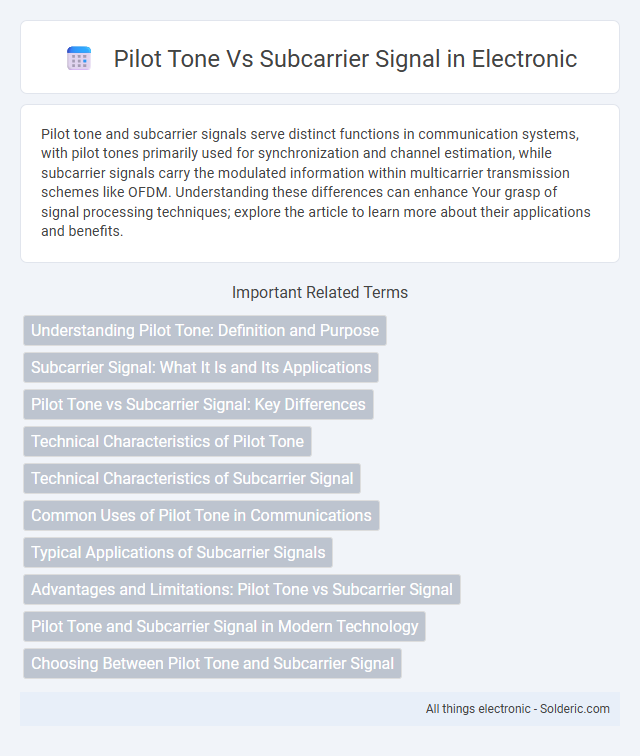Pilot tone and subcarrier signals serve distinct functions in communication systems, with pilot tones primarily used for synchronization and channel estimation, while subcarrier signals carry the modulated information within multicarrier transmission schemes like OFDM. Understanding these differences can enhance Your grasp of signal processing techniques; explore the article to learn more about their applications and benefits.
Comparison Table
| Feature | Pilot Tone | Subcarrier Signal |
|---|---|---|
| Definition | A reference tone used to stabilize or synchronize signals. | An additional carrier wave modulated to carry extra information. |
| Frequency | Fixed, typically at a low frequency within the system bandwidth. | Higher frequency, distinct from the main carrier frequency. |
| Purpose | Facilitates synchronization and channel estimation. | Transmits auxiliary data or separate audio/video channels. |
| Modulation | Usually unmodulated or simple tone. | Modulated with additional information (AM, FM, or PM). |
| Application | Used in television broadcasting and radio for synchronization. | Used in stereo audio, multiplexing, and multi-channel communication. |
| Signal Complexity | Simple and constant signal. | Complex, carries encoded data. |
Understanding Pilot Tone: Definition and Purpose
Pilot tone refers to a continuous, fixed-frequency signal embedded within a communication system to aid in synchronization and channel estimation. It serves as a reference signal, enabling receivers to accurately detect timing, frequency shifts, and phase variations during data transmission. Unlike subcarrier signals that carry user information modulated at varying frequencies, pilot tones primarily provide stability and coherence in signal processing, enhancing overall system performance.
Subcarrier Signal: What It Is and Its Applications
A subcarrier signal is a secondary signal modulated onto a primary carrier wave to transmit additional information without interfering with the main signal, commonly used in television broadcasting, FM stereo radio, and telemetry systems. It enables multiplexing of multiple data streams by embedding audio, control signals, or auxiliary data within the main transmission bandwidth. This technique enhances communication efficiency by supporting simultaneous transmission of diverse content such as stereo audio channels or closed captioning in digital broadcasts.
Pilot Tone vs Subcarrier Signal: Key Differences
Pilot tone serves as a reference signal for synchronization and phase stability in communication systems, while a subcarrier signal carries additional information by modulating the main carrier frequency. The pilot tone typically operates at a fixed frequency and helps maintain coherent demodulation, whereas subcarrier signals vary depending on the data they transmit. Understanding these distinctions improves your ability to optimize signal processing and communication system design.
Technical Characteristics of Pilot Tone
Pilot tone exhibits a stable frequency typically in the range of 15 kHz to 30 kHz, serving as a reference signal for synchronization and channel estimation in communication systems. It maintains low modulation depth and high signal-to-noise ratio, ensuring minimal interference while enabling accurate timing and phase recovery. The pilot tone's consistent amplitude and phase characteristics make it essential for coherent demodulation and adaptive equalization processes.
Technical Characteristics of Subcarrier Signal
The subcarrier signal operates at a higher frequency than the pilot tone, enabling efficient modulation of additional data channels within the main carrier wave. It exhibits a stable frequency offset, typically in the range of several kilohertz to hundreds of kilohertz, which allows for robust signal separation and minimizes interference. The subcarrier's amplitude and phase stability are critical technical characteristics that ensure reliable demodulation and accurate retrieval of transmitted information.
Common Uses of Pilot Tone in Communications
Pilot tones are commonly used in communications for carrier synchronization, aiding receivers in demodulating signals accurately by providing a reference frequency. They help maintain signal integrity in radio broadcasting, digital TV, and satellite communications by enabling automatic gain control and frequency tracking. Your communication systems benefit from pilot tones by ensuring stable transmission and minimizing errors in data reception.
Typical Applications of Subcarrier Signals
Subcarrier signals are commonly used in analog and digital communication systems to carry additional information alongside the main carrier, such as audio channels in television broadcasting or data transmission in FM radio. Your devices benefit from subcarrier signals when transmitting multiple streams of information simultaneously, like stereo audio or closed captions. These signals enable efficient bandwidth utilization and enhance the functionality of multimedia systems.
Advantages and Limitations: Pilot Tone vs Subcarrier Signal
Pilot tone offers precise carrier frequency reference, enhancing synchronization accuracy in communication systems but can introduce interference in high data rate transmissions. Subcarrier signals enable multiplexing multiple channels and improve bandwidth utilization, though they may suffer from increased complexity and susceptibility to phase noise. Choosing between pilot tone and subcarrier signal depends on system requirements for synchronization precision and spectral efficiency.
Pilot Tone and Subcarrier Signal in Modern Technology
Pilot tone and subcarrier signals play critical roles in modern communication systems, particularly in RF and digital broadcasting technologies. A pilot tone serves as a reference signal to assist in carrier synchronization, channel estimation, and frequency offset correction, ensuring stable and accurate data transmission. Your devices rely on subcarrier signals to carry additional information like audio, video, or control data within the main carrier wave, optimizing bandwidth usage and enhancing overall signal integrity.
Choosing Between Pilot Tone and Subcarrier Signal
Choosing between a pilot tone and a subcarrier signal depends on your system's synchronization and modulation needs. A pilot tone provides a constant reference frequency for carrier recovery and simplifies demodulation, making it ideal for systems requiring stability and low complexity. Subcarrier signals offer more flexibility in carrying additional information, supporting multiplexing and advanced modulation schemes in complex communication setups.
Pilot tone vs subcarrier signal Infographic

 solderic.com
solderic.com